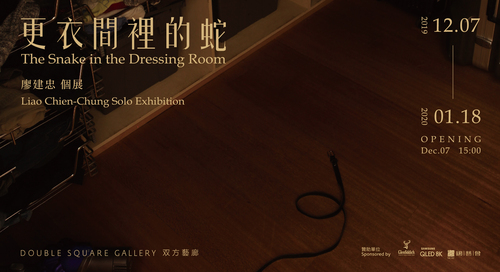The Snake in the Dressing Room- Liao Chien-Chung Solo Exhibition
12/7/2019 (Sat) - 1/18/2020 (Sat)
Liao Chien-Chung

Exhibition dates:2019.12.07-2020.01.18 (Tue.-Sat., 10.30-18.30)
Exhibition venue:Double Square Gallery
Opening reception:2019.12.07 (Sat.)15:00
Academic research:Wu Chieh-Hsiang
Double Square Gallery is pleased to present artist Liao Chien-Chung’s first solo exhibition at the gallery, titled The Snake in the Dressing Room, which runs from December 7, 2019 to January 18, 2020. In the exhibition, the artist continues the creative context of Surface Engineering Method to explore the gray area between reality and pretension while responding to various conundrums and problems that individuals encounter in contemporary society. Wu Chieh-Hsiang, Associate Professor at the Department of Fine Arts, National Changhua University of Education, is specially invited to serve as the academic chair of the exhibition that features nine installations, including three works created for and acquired by the Glenfiddich Artists in Residence program in Scotland during this summer.
This imagined fear has taken its root in the potential threats in reality—a kind of unignorable malice that persists in our living experiences, such as the political reality, the class-specific everyday escapism, an imperfect era and our collective fate, all of which we lack the ability to break away from. —Liao Chien-Chung
The exhibition title, The Snake in the Dressing Room, is inspired by the artist’s personal daily experience. Living and working for years in the mountains in Taipei’s Bali, the artist thought he has grown used to seeing snakes; however, he was still spooked by a belt on the floor of a dark dressing room. The artist has been drawn to explore the existential anxiety and uneasy mindset revealed by people’s preconceived ideas that have cost them the ability to make accurate judgments. Be it about recognizing differences in social class or restraints of moral codes, for Liao, the imagined fear is closely intertwined with the potential threats in reality. Additionally, he has exceled at using features of a given exhibition space as well as drawing power from the theatricality based on visual illusions and stage props. Regarding the exhibited works and the exhibition title, Wu states that “the arrangement in The Snake in the Dressing Room continuously produces a tension between props and artworks, and presents scenarios that forebode misfortune while demonstrating the everyday life informed by a sense of crisis, tantalizing the audience’s immediate and complex psychological mechanism.” By introducing heterogeneous elements, the artist motivates people to examine the familiar everyday environment, draws out the narrative of personal life behind the mimicked objects, and expresses the social issues he cares about.
On view in this exhibition is a work entitled Pickup Truck, which comprises of wood plank, metal and plastic. The artist creates a freeze-frame scene of a car accident with a realistic yet unfunctional pickup truck in 1:1 ratio that is surrounded by flying and fallen gas tanks. Earthquake Resistant Steel Structure reveals an indoor steel structure for resisting earthquakes, which is in fact made of wood. Because of the “steel structure,” the gallery seems to be housed in a high-risk, dangerous building, rendering the atmosphere rather nerve-wrecking yet intriguing. Utilizing mimetic sculptures, Liao delineates the concept of “fake” with realistic forms, formulating a dialectics between real objects, art installations and failed disguises.
In the summer of 2019, Liao conducted an artist residency at a distillery in Scotland, during which he learned about the traditional production method of whisky, the local environment, the brand’s history and value. He then combined what he learned with his refined skills to ingeniously replicate everyday objects he saw in Dufftown, including a wine barrel that seems heavy but is in fact light, a rusty manhole cover that is inconspicuous but plays a crucial role in the distillery, and a wooden door of the distillery that permits no entry. The artist uses his wood and plastic works to imitate objects from the distillery, and these works with mimetic surfaces stripped of real functions create an imaginative space that invites further rumination.